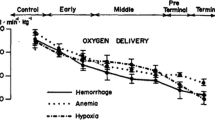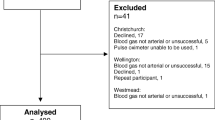Abstract
Objective
The aim of this study was to compare the accuracy of the CeVOX monitor measuring continuous central venous saturation (ScvO2) with laboratory blood gas oximetry under clinical circumstances.
Design
Prospective, multicentre, observational study.
Setting
Five adult general intensive care units.
Patients and participants
Fifty-three critically ill patients.
Interventions
The fibre-optic probe was inserted into an ordinary central venous catheter's distal lumen. Blood samples were taken from this line via a Y-adapter every 8 h and ScvO2 was measured with a laboratory co-oximeter. Patients were observed for a maximum of 5 days. Results were compared using linear regression and the Bland and Altman plots.
Measurements and results
The 526 matched pairs of ScvO2 showed a significant correlation between the two methods (r = 0.79, p< 0.001). Bland–Altman plots showed an overall mean bias of –0.3% and moderate agreement (lower and upper levels of agreement: –13.2% and 12.5%). Correlation for the first time point, and for differences between the first two time points for each method revealed good correlation: (n = 53): r = 0.79, p< 0.001; (n = 50): r = 0.58, p< 0.001, respectively.
Conclusion
These results in a heterogeneous group of critically ill patients show that continuous ScvO2 monitoring by the CeVOX technology yielded results comparable with those obtained by laboratory co-oximetry and therefore can be relied on in everyday clinical practice.

Similar content being viewed by others
References
Antonelli M, Levy M, Andrews PJ, Chastre J, Hudson LD, Manthous C, Meduri GU, Moreno RP, Putensen C, Stewart T, Torres A (2007) Hemodynamic monitoring in shock and implications for management: International Consensus Conference, Paris, France, 27–28 April 2006. Intensive Care Med 33:575–590
Rivers E, Nguyen B, Havstad S, Ressler J, Muzzin A, Knoblich B, Peterson E, Tomlanovich M (2001) Early goal-directed therapy in the treatment of severe sepsis and septic shock. N Engl J Med 345:1368–1377
Rady MY, Rivers EP, Nowak RM (1996) Resuscitation of the critically ill in the ED: Responses of blood pressure, heart rate, shock index, central venous oxygen saturation, and lactate. Am J Emerg Med 14:218–225
Reinhart K, Kuhn HJ, Hartog C, Bredle DL (2004) Continuous central venous and pulmonary artery oxygen saturation monitoring in the critically ill. Intensive Care Med 30:1572–1578
Ladakis C, Myrianthefs P, Karabinis A, Karatzas G, Dosios T, Fildissis G, Gogas J, Baltopoulos G (2001) Central venous and mixed venous oxygen saturation in critically ill patients. Respiration 68:279–285
Huber D, Osthaus WA, Optenhöfel J, Breymann T, Marx G, Piepenbrock S, Sumplemann R (2006) Continuous monitoring of central venous oxygen saturation in neonates and small infants: in vitro evaluation of two different oximetry catheters. Pediatr Anesth 16:1257–1261
Bland JM, Altman DG (1986) Statistical methods for assessing agreement between two methods of clinical measurement. Lancet 1:307–310
Bland JM, Altman DG (1995) Calculating correlation coefficients with repeated observations. 2. Correlation between subjects. Br Med J 11:310–633
Bland JM, Altman DG (1995) Calculating correlation coefficients with repeated observations. 1. Correlation within subjects. Br Med J 18:310–446
Reinhart K, Bloos F (2005) The value of venous oximetry. Curr Opin Crit Care 11:259–263
Nakazawa N, Hikawa Y, Saitoh Y, Tanaka N, Yasuda K, Amaha K (1994) Usefulness of central venous oxygen saturation monitoring during cardiopulmonary resuscitation. Intensive Care Med 20:450–451
Osthaus WA, Huber D, Beck C, Roehler A, Marx G, Hecker H, Sumpelmann R (2006) Cardiac output: correlation with central venous oxygen saturation, mean arterial pressure and heart rate in piglets. Paediatr Anaesth 16:944–947
Varpula M, Karlsson S, Ruokonen E, Pettila V (2006) Mixed venous oxygen saturation cannot be estimated by central venous oxygen saturation in septic shock. Intensive Care Med 32:1336–1343
Scalea TM, Hartnett RW, Duncan AO, Atweh NA, Phillips TF, Sclafani SJ, Fuortes M, Shaftan GW (1990) Central venous oxygen saturation: a useful clinical tool in trauma patients. J Trauma 30:1539–1543
Bannon MP, O'Neill CM, Martin M, Ilstrup DM, Fish NM, Barrett J (1995) Central venous oxygen saturation, arterial base deficit, and lactate concentration in trauma patients. Am Surg 61:738–745
Lundberg JS, Perl TM, Wiblin T, Costigan MD, Dawson J, Nettleman MD, Wenzel RP (1998) Septic shock: an analysis of outcomes for patients with onset in hospital wards versus intensive care units. Crit Care Med 26:1020–1024
Lefrant JY, Muller L, Bruelle P, Pandolfi JL, L'Hermite J, Peray P, Saissy G, de La Coussaye JE, Eledjam JJ (2000) Insertion time of the pulmonary artery catheter in critically ill patients. Crit Care Med 28:355–359
Dueck MH, Klimek M, Appenrodt S, Weigand C, Boerner U (2005) Trends but not individual values of central venous oxygen saturation agree with mixed venous oxygen saturation during varying hemodynamic conditions. Anesthesiology 103:249–257
Hofer C, Ganter M, Fodor P, Tavakoli R, Genoni M, Yollinger A (2006) Continuous central venous oxygenation measurement by CeVOX in patients undergoing off-pump coronary artery bypass grafting. Crit Care 10 [Suppl]:P40
Critchley LA, Critchley JA (1999) A meta-analysis of studies using bias and precision statistics to compare cardiac output measurement techniques. J Clin Monit Comput 15:85–91
Author information
Authors and Affiliations
Corresponding author
Rights and permissions
About this article
Cite this article
Molnar, Z., Umgelter, A., Toth, I. et al. Continuous monitoring of ScvO2 by a new fibre-optic technology compared with blood gas oximetry in critically ill patients: a multicentre study . Intensive Care Med 33, 1767–1770 (2007). https://doi.org/10.1007/s00134-007-0743-7
Received:
Accepted:
Published:
Issue Date:
DOI: https://doi.org/10.1007/s00134-007-0743-7




